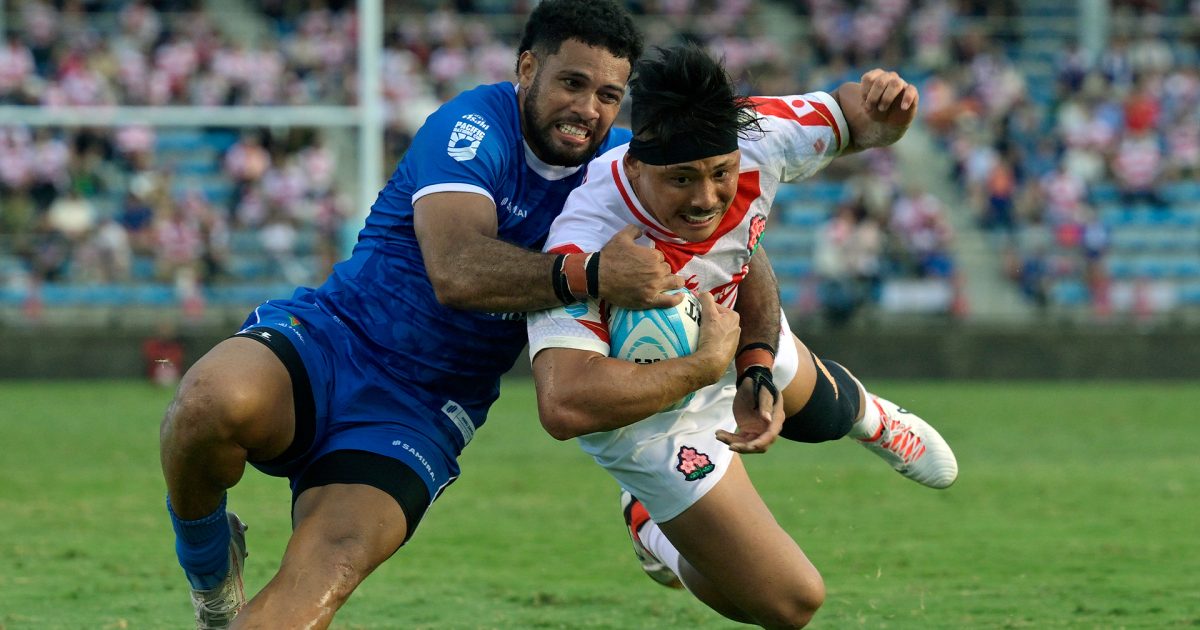Japan's strike power proves too much for resilent Samoa in semi-final

The third match of the Pacific Nations Cup saw Japan take on Samoa on September 15th, in the lingering summer heat. Japan secured a convincing 49-27 victory, advancing to the final against Fiji next weekend.
With temperatures at 32°C and winds of 8 meters per second, Samoa had the wind advantage at kickoff. Full-back Seungsin Lee started strongly for Japan, and lock Warner Dearns applied early pressure, energizing the crowd.
In the first minute, Samoa was penalized for not rolling away, allowing Japan to kick to touch near the try line. From the lineout maul, hooker Mamoru Harada brought Japan closer to the try line.
Continued pressure led to another penalty, and Japan opted for another lineout. In the 7th minute, Japan launched an attack from the lineout. Fly-half Harumichi Tatekawa passed to wing Malo Tuitama, and full-back Lee’s kick was collected by midfield Dylan Riley, who scored near the right post. Lee’s successful conversion put Japan ahead 7-0.
By the 9th minute, Japan was pressing Samoa’s goal line again. Samoa was penalized for a deliberate knock-down, resulting in a penalty try and extending Japan’s lead to 14-0 within 10 minutes. Samoa’s wing, Elisapeta Alofipo, was shown a yellow card.
Samoa responded in the 13th minute with a scrum around Japan’s 10-meter line. Back-row Iakopo Petelo broke through, and right-wing Tuna Tuitama scored near the right post, closing the gap to 14-7.
In the 18th minute, despite Lee being tackled while executing a kick pass, wing Tomoki Osada collected the ball and scored, extending Japan’s lead to 21-7. Samoa, despite their strong physicality, struggled to maintain their attacks, often rushing and becoming isolated.
In the 24th minute, Samoa added three points with a penalty goal after Japan was offside, making it 21-10. In the 28th minute, Lee was penalized for not releasing, and Samoa slotted another penalty goal, narrowing the score to 21-13.
Japan’s early momentum began to wane around the 20-minute mark. In the 31st minute, another penalty for not releasing pushed Japan deep into their own territory. However, Japan regained control in the 32nd minute when Dearns played a key role in forcing Samoa into an unplayable maul, breaking the negative flow for Japan.
In the 39th minute, after a lineout near the Samoan goal line, Riley made a strong run. Following several phases, Tatekawa passed to full-back Lee, who scored in the left corner. Lee’s tough conversion was successful, making it 28-13 at halftime.
In the second half, Samoa kicked off, but Japan quickly turned over possession through midfielder McCurran, launching an attack. Lee’s kick pass was collected by wing Osada near the touchline, who offloaded back to Lee. Back-row Shimokawa supported and scored near the right post. Lee’s conversion extended Japan’s lead to 35-13.
In the 51st minute, Samoa’s scrum-half Melani Matavao broke through and scored, reducing the gap to 35-20.
However, in the 57th minute, Japan mounted a forward-driven attack near Samoa’s goal line, with scrum-half Shinobu Fujiwara scoring under the posts, making it 42-20.
In the 61st minute, Tatekawa was substituted, with Lee moving to fly-half.
With less than 10 minutes to go in the game, Lee’s kick was caught by Rodney Iona, who linked up with his teammates to score near the left post, cutting the deficit to 42-27.
With 3 minutes left, Japan opted for a scrum near the Samoan goal after a penalty. Fujiwara passed to Kajimura, who found reserve full-back Taichi Takahashi to score near the right post. Lee continued his perfect streak, converting all his kicks and sealing a 49-27 victory.
Tatekawa, playing as Japan’s fly-half for the first time since the 2015 Rugby World Cup game against Scotland, controlled the game throughout and played a key role in Japan’s advancement to the final.
Lee, making his debut as a full-back in a Test match, converted all his kicks and was named Player of the Match.































